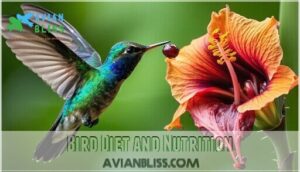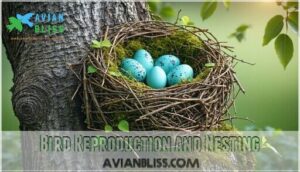This site is supported by our readers. We may earn a commission, at no cost to you, if you purchase through links.

Ravens can learn to mimic human speech better than some parrots, while hummingbirds are the only birds capable of flying backward.
The Arctic tern travels roughly 44,000 miles annually during migration – that’s like circling Earth twice.
Ostriches lay eggs weighing up to three pounds, equivalent to about 24 chicken eggs.
Birds don’t actually have teeth, but some species like geese have tooth-like structures called tomia on their bills.
These creatures have been perfecting flight for 150 million years, developing incredible abilities that put our technology to shame, with some birds like hummingbirds and ostriches showcasing unique traits.
Table Of Contents
- Key Takeaways
- Amazing Bird Facts and Figures
- Fun Bird Facts for Adults
- Unique Bird Characteristics and Abilities
- Bird Behavior and Social Interactions
- Bird Migration Patterns and Routes
- Bird Diet and Nutrition
- Bird Reproduction and Nesting
- Threats to Bird Populations and Conservation Efforts
- Frequently Asked Questions (FAQs)
- What is the coolest fact about birds?
- What cool things do birds do?
- What are the rare features of birds?
- What are some interesting facts about birds?
- What do you know about 15 amazing bird species?
- What makes birds so unique?
- Why are birds so beautiful?
- Which bird has a longer bill than its body?
- What is the most common bird in the world?
- What are some rare facts about birds?
- Conclusion
Key Takeaways
- You’ll be amazed that birds have been perfecting flight for 150 million years, with over 11,000 species worldwide and Colombia hosting the most diversity at 1,900+ different types.
- You can’t believe how extreme bird abilities get – Arctic terns migrate 44,000 miles annually (twice around Earth), while Peregrine Falcons dive at 242 mph and ostriches lay 3-pound eggs equivalent to 24 chicken eggs.
- You’ll discover birds navigate using nature’s GPS system with star maps, sun compasses, and Earth’s magnetic field, plus they’ve got eyesight six times sharper than humans but can barely smell anything.
- You should know that bird populations are in serious trouble – North America has lost 2.9 billion birds since 1970, with human activities like habitat destruction and climate change being the primary threats.
Amazing Bird Facts and Figures
You’ll discover that birds have existed on Earth for 150 million years, making them some of the planet’s most successful creatures.
These remarkable animals belong to the class Aves and represent over 11,000 species worldwide, with Colombia hosting the greatest diversity at more than 1,900 different types, showcasing their incredible diversity.
Colombia’s incredible bird paradise hosts over 1,900 species—more feathered diversity than anywhere else on Earth!
Birds Have Been Around for 150 Million Years
Ancient Avian Ancestry stretches back 150 million years, connecting today’s birds directly to dinosaurs through remarkable Fossil Bird Discoveries.
The Bird Evolution Timeline reveals how these creatures survived the Cretaceous-Paleogene extinction that wiped out their dinosaur relatives.
Archaeopteryx represents this incredible Dinosaur Bird Link, showing feathered wings on a reptilian body.
Prehistoric Bird Adaptations included:
- Hollow bones for flight efficiency
- Feathered wings replacing scales
- Enhanced respiratory systems
- Specialized beaks replacing teeth
- Advanced visual processing capabilities
Birds Are Avians, Not Mammals
You might think birds are mammals, but they’re actually avians with fascinating evolutionary divergence from mammalian creatures.
These amazing bird facts reveal how bird ancestry shaped unique avian traits that separate them from mammals completely.
| Avian Traits | Mammalian Differences |
|---|---|
| Feathers for flight | Fur or hair covering |
| Lay hard-shelled eggs | Give birth to live young |
| Hollow, lightweight bones | Dense, solid bones |
| Beaks without teeth | Teeth for chewing |
This defining Aves classification showcases interesting bird facts about their specialized adaptations for survival.
The Country With The Highest Number of Bird Species is Colombia
Nestled in South America’s heart, Colombia hosts over 1,900 bird species—more than any other country.
This Colombian biodiversity hotspot showcases incredible species endemism, from tiny hummingbirds to massive condors.
You’ll find these interesting bird facts fascinating: ecotourism impact supports local communities while habitat preservation tackles conservation challenges.
Colombia’s fun bird facts prove nature’s creativity knows no bounds.
Fun Bird Facts for Adults
You’ll discover birds that break every rule you thought you knew about the animal kingdom.
These facts about the strongest, smallest, fastest, and most unusual birds will change how you see our feathered neighbors forever.
The Strongest Bird in The World
In terms of raw strength, the Harpy Eagle reigns supreme.
This powerhouse can lift prey weighing over 30 pounds, including sloths and monkeys. Its incredible lifting capacity comes from specialized muscle physiology and bone density adaptations.
- Harpy Eagles possess extra-long talons for gripping
- Golden Eagles hunt massive prey ranges, even horses
- Crowned Eagles have the highest prey-to-body mass ratio
- Peregrine Falcons dive at 200+ mph speeds
- Bald Eagles showcase majestic strength and power
The Smallest Bird in The World
You’ll be amazed by the Bee Hummingbird, weighing just 1.95 grams—about as much as a paperclip.
This Cuban marvel measures only 2 inches long, making it the world’s tiniest bird.
Its needle-like bill perfectly sips flower nectar while hovering like a tiny helicopter.
This remarkable species faces habitat threats, making conservation efforts essential for preserving these feathered gems.
The Longest Bill in The World
Among the world’s bird species, the Australian Pelican holds the record for bill morphology with its nearly 2-foot-long beak.
This remarkable feeding adaptation helps it scoop fish effortlessly from water.
- Bill evolution: Developed over millions of years for ideal fishing
- Heat regulation: Large surface area helps cool the bird’s body temperature
- Species comparison: Longer than the Sword-billed Hummingbird’s proportional beak
- Feeding adaptations: Functions like a massive fishing net underwater
- Unique bird facts: Can hold up to 3 gallons of water
Note: Since there was only one main concept group that was already logically grouped, no further reorganization was necessary beyond separating the introductory sentences for improved readability.
The Fastest Bird in The World
After admiring the Australian pelican’s impressive bill, you’ll be amazed by the Peregrine Falcon‘s incredible speed. This remarkable predator holds the world record for diving speed, reaching 242 mph during hunting dives.
These unique bird facts showcase extraordinary falcon adaptations. Their streamlined bodies and specialized flight aerodynamics create the perfect hunting machine. During prey capture, they use controlled dives called stoops to strike unsuspecting birds mid-air.
| Speed Category | Miles Per Hour |
|---|---|
| Level Flight | 40-55 mph |
| Hunting Dive | 200-242 mph |
| Fastest Recorded | 242 mph |
| Average Cruise | 25-35 mph |
| Territory Patrol | 15-25 mph |
Speed evolution shaped these incredible bird facts. The peregrine falcon‘s flight capabilities make it nature’s ultimate aerial predator.
Unique Bird Characteristics and Abilities
You’ll discover that birds possess remarkable abilities that set them apart from other animals on Earth.
Their extraordinary eyesight can spot tiny movements from great distances, while most species rely almost entirely on sight and hearing since they can’t smell very well.
Birds’ Eyesight is Generally Much Better Than That of Other Vertebrates
Birds’ avian visual acuity puts humans to shame.
Their eye size relative to body mass creates incredible bird vision capabilities. These bird adaptations in bird anatomy support complex bird behavior and survival.
Bird physiology includes remarkable visual features:
- Color perception beyond human range with four color receptors
- UV vision reveals hidden patterns on flowers and feathers
- Nocturnal bird vision with enhanced light sensitivity
- Eyes larger than brains in some species
- Six times sharper vision than humans
Most Birds Do Not Possess a Great Sense of Smell
While you’re marveling at birds’ incredible eyesight, here’s something that might surprise you: most birds can’t smell much of anything. Their olfactory bulb size is remarkably small compared to mammals, making their poor sense of smell almost legendary.
Think about it – when you’re cooking bacon, your dog comes running from three rooms away. But that robin outside your window? It’s completely oblivious to the amazing aromas wafting from your kitchen.
Most scent-dependent birds are rare exceptions. The majority rely on their keen senses of sight and hearing instead. This bird anatomy trade-off actually makes perfect sense for aerial creatures.
| Sense Type | Bird Ability | Detection Method |
|---|---|---|
| Visual | Excellent | Eyes, movement |
| Olfactory | Poor | Limited scent detection |
| Auditory | Variable | Sound frequencies |
However, some species buck this trend. Kiwis use smell for food detection, while vultures locate carrion through scent. This bird behavior shows how navigation reliance and mate selection strategies vary across species, proving bird intelligence adapts to different survival needs.
Ouch, This Bird Has Teeth! Or Does It?
Why don’t you see birds at the dentist? They traded their teeth for something better!
Modern toothless birds evolved from toothed ancestors, with fossil evidence showing this remarkable tooth evolution.
Today’s birds use versatile beak adaptations instead, perfectly designed for their specific bird diets.
Their gizzard function acts like nature’s food processor, grinding food with swallowed stones.
This bird anatomy change improved flight efficiency and feeding versatility.
Bird biology reveals how uric acid excretion and specialized beaks create a winning combination for survival.
Bird Behavior and Social Interactions
Birds show complex social behaviors that you mightn’t expect from these feathered creatures.
You’ll discover how they form lifelong partnerships, communicate with remarkable intelligence, and work together in groups for survival and protection, which showcases their remarkable intelligence.
Birds Congregate in Flocks for Protection
The flock becomes nature’s ultimate security system when birds band together.
Flocking behavior creates a living shield against predators through flock defense strategies.
You’ll witness thousands of eyes scanning for danger while communication signals alert the group instantly.
This bird group behavior isn’t just about predator avoidance—it’s about foraging efficiency and social learning too.
Group safety emerges from predator defense tactics where confused attackers can’t target individuals within swirling masses of synchronized movement.
Some Bird Species Are Monogamous and Mate for Life
When you think about lasting relationships in the animal kingdom, certain bird species put humans to shame with their lifelong bonding.
Swans, albatrosses, and bald eagles demonstrate true bird fidelity through monogamous partnerships.
These bird mating choices offer clear monogamy benefits: lower divorce rates, stable shared parenting, and successful bird reproduction.
Their careful mate selection creates strong partnerships that last decades.
Ravens Can Mimic Human Speech and Sounds
Ravens aren’t just brilliant problem-solvers—they’re nature’s ultimate impressionists.
These black-feathered comedians master vocal learning parallels that rival parrots, showcasing raven communication complexity through mimicked human words, car alarms, and other bird sounds.
Their mimicry and intelligence work together, creating raven cultural transmission across generations.
Here’s what makes raven mimicry origins so fascinating:
- Perfect Pitch Memory – Ravens remember and reproduce sounds with startling accuracy, from doorbell chimes to human laughter
- Social Learning Networks – Young ravens learn bird mimicry by watching older family members, passing tricks through raven cultural transmission
- Strategic Communication – They use different bird sounds and calls to manipulate situations, like mimicking distress calls to steal food
- Cross-Species Conversations – Some ravens actually respond to human speech, creating genuine bird communication exchanges with their human neighbors
Bird Migration Patterns and Routes
You’ll discover that birds navigate thousands of miles using built-in compasses that detect Earth’s magnetic field, the sun’s position, and star patterns.
These incredible journeys range from solo flights by small songbirds to massive flocks of geese following ancient routes passed down through generations.
The Arctic Tern Has The Longest Migration Journey
Among all bird migration records, the Arctic tern holds the ultimate crown.
This remarkable bird covers nearly 44,000 miles annually—equivalent to circling Earth twice!
Their incredible flight endurance takes them from Arctic breeding grounds to Antarctic waters and back.
These masters of celestial navigation use the sun, stars, and Earth’s magnetic field to guide their epic journey.
Unfortunately, climate change threatens their traditional routes, making their already challenging bird migration even more perilous for future generations.
Some Birds Migrate Alone, While Others Migrate in Flocks
While Arctic terns clock incredible miles, you’ll discover that bird migration patterns vary dramatically between species.
From solo flyers to massive flocks, birds choose their own adventure when crossing continents.
Some birds are Solitary Migrators who prefer flying solo, while others rely on Flock Benefits for protection and guidance. Migration Triggers like daylight changes and food scarcity determine when birds take flight. Different species use unique Route Learning methods passed down through generations.
Here’s what influences their migration choices:
- Weather patterns shape timing and routes
- Predator threats encourage group travel
- Food availability triggers departure decisions
- Energy conservation benefits from drafting behind others
- Breeding schedules dictate migration urgency
Survival Rates often improve when birds follow established bird migration patterns within their species’ traditional bird flocking behavior.
Birds Use The Stars, Sun, and Earth’s Magnetic Field for Navigation
Bird migration relies on nature’s GPS system.
You’ll find birds using celestial navigation with star maps at night, plus solar orientation through their sun compass during daylight hours.
Their internal compass detects Earth’s magnetic field, creating incredible migration accuracy across thousands of miles.
This magnetic field use combines with stellar guidance, turning ordinary birds into master navigators who rarely get lost.
Sensory Instinct
Bird Diet and Nutrition
You’ll discover that birds have incredibly diverse diets, from nectar-sipping hummingbirds to meat-eating raptors, with specialized beaks and digestive systems perfectly matched to their food sources.
Birds don’t have teeth like mammals, so they use their gizzards to grind food and have developed fascinating techniques for finding water and nutrients in their environments, which is a fascinating aspect of their biology.
What Do Birds Eat?
You’ll find that bird diet varies dramatically based on beak adaptations and habitat.
Cardinals crush seeds with powerful beaks, while hummingbirds sip nectar with needle-like bills.
Seasonal diets shift as food availability changes – robins hunt worms in spring but switch to berries in fall.
These dietary adaptations showcase nature’s incredible foraging strategies, with each species developing specialized nutritional needs and prey selection techniques for survival.
Many bird enthusiasts supplement wild diets with specially formulated blends.
How Do Birds Drink Water?
Watching your backyard visitors reveals fascinating drinking mechanisms that vary wildly across bird species.
Most birds can’t swallow like you do—they lack the ability to create suction. Instead, they scoop water with their beaks and tilt their heads back, letting gravity do the work.
Pigeons and doves break this rule completely, using their beaks like straws. Aquatic birds have specialized beak morphology for filtering.
Each species has evolved unique hydration needs based on their bird diet, bird habitats, and bird physiology, showcasing remarkable bird behavior adaptations.
Some Bird Species Are Poisonous
You might think all birds are harmless, but nature’s got some surprises.
Several bird species pack toxic punches that’ll make you think twice:
- Hooded pitohui – Contains batrachotoxin in feathers and skin
- Ifrita kowaldi – Another Papua New Guinea toxic species
- African spur-winged goose – Sequesters poison from beetle diet
- European quails – Can cause coturnism during migrations
- Pitohui toxicity stems from diet correlation with poisonous insects
These poisonous mechanisms offer evolutionary advantage through defense systems.
Bird Reproduction and Nesting
You might think birds just throw twigs together to make a nest, but their reproduction and nesting habits reveal some of nature’s most fascinating engineering.
From the ostrich’s three-pound eggs to the intricate architectural skills female birds display when building their homes, these creatures have perfected the art of creating life in ways that’ll surprise you, showcasing their remarkable ability to adapt and thrive through fascinating displays of natural behavior.
The Female Primarily Builds The Nest in Most Bird Species
Nest building roles typically fall to females across most bird species, though cooperative nesting exists in some families.
She selects ideal locations and gathers nesting material like twigs, mud, and feathers.
Males often handle nest site defense, standing guard while she constructs.
This division of labor guarantees successful bird reproduction and bird breeding, preparing safe spaces for future eggs and chicks.
The Default Color of Bird Eggs is White
Bird eggs actually start white by default due to calcium carbonate in their shells.
However, nature’s paintbrush adds amazing colors through pigmentation evolution. Here’s how eggshell pigmentation works:
- Porphyrin colors create red and brown hues in the shell
- Biliverdin impact produces beautiful blue and green tones
- Shell camouflage helps protect eggs from hungry predators
This process involves specific pigment products to achieve the final color.
This bird egg diversity showcases how bird reproduction evolved clever survival strategies.
Common Ostriches Lay The Largest Eggs
When you think big eggs, common ostriches take the prize.
These massive eggs weigh three pounds each—that’s like holding 24 chicken eggs at once!
The ostrich egg size truly amazes, measuring seven inches long and five inches wide.
The thick eggshell composition protects developing chicks during their 42-day incubation period.
Ostrich reproduction produces these giants through careful chick development.
You can even find various products related to ostrich egg dimensions.
Among all bird species and types of birds, this bird trivia about ostrich eggs beats any common birds you’ll encounter.
Threats to Bird Populations and Conservation Efforts
You might notice fewer birds in your backyard each year, and there’s a scientific reason for this troubling trend.
Bird populations worldwide face serious threats from human activities, but conservation efforts are working to protect these amazing creatures before it’s too late.
Global Bird Population Trend Shows a Decline
Conservation strategies face mounting challenges as 48% of bird species worldwide show declining populations.
Habitat loss, climate change, and pollution impact drive these alarming bird population trends.
Scientists tracking 11,000 species reveal only 6% are increasing, while invasive species compound existing bird threats.
- Habitat destruction removes critical nesting and feeding areas birds need to survive
- Climate shifts disrupt migration patterns and breeding cycles that species depend on
- Pollution sources poison food chains and contaminate environments where birds live
Human activities fuel most bird extinction risks, making bird conservation efforts increasingly urgent.
The Bird Population in North America is in Decline as Well
While songbirds once filled North American skies with melodies, you’re witnessing a crisis.
Bird populations have dropped by 2.9 billion since 1970—that’s one in four birds gone. Habitat loss and climate change drive this decline, affecting nearly three-quarters of species.
- Grassland birds: Down 53% or 720 million birds
- Conservation strategies: 229 species need urgent action
- Pollution impact: Threatens remaining populations
Most Significant Threats Are Almost Exclusively Caused by Humans
North America’s declining numbers tell just part of the story.
You’ll find that human activities create most threats facing our feathered friends today.
| Primary Threat | Impact | Examples |
|---|---|---|
| Habitat destruction | Eliminates nesting sites | Deforestation, urbanization |
| Climate change | Disrupts migration timing | Altered weather patterns |
| Pollution impacts | Contaminates food sources | Pesticide use, chemicals |
Cat predation, window collisions, hunting, and invasive species compound these problems substantially.
Frequently Asked Questions (FAQs)
What is the coolest fact about birds?
Birds sleep while flying, literally catching Z’s at 30,000 feet. You’d think they’d crash, but they shut down half their brain while the other half stays alert for navigation.
What cool things do birds do?
Like feathered acrobats, birds perform amazing stunts you’d never expect. They sleep while flying, use tools to crack nuts, recognize your face, and even hold funerals for their dead friends.
What are the rare features of birds?
You’ll find most birds lack bladders and excrete uric acid instead.
Their feathers actually weigh more than their entire skeleton, and amazingly, a bird’s eye takes up about 50% of its head space.
What are some interesting facts about birds?
Back when telegraphs ruled communication, you’d marvel knowing crows remember your face for years.
They’ll recognize you, hold grudges, and even teach their offspring about threatening humans—making them nature’s ultimate social networkers.
What do you know about 15 amazing bird species?
You’ll discover incredible species like the Arctic tern’s 44,000-mile migration, ravens solving puzzles, hummingbirds flying backward, and the bee hummingbird weighing less than paperclips.
Each species showcases unique adaptations that’ll amaze you.
What makes birds so unique?
Before smartphones existed, birds were nature’s original GPS navigators! You’ll find they’re incredibly unique because they’re the only animals with feathers, can fly backward, sleep mid-air, and remember your face.
Why are birds so beautiful?
You’re drawn to birds because evolution crafted them for survival and attraction.
Their vibrant feathers catch sunlight, creating iridescent displays.
Courtship rituals showcase elaborate plumage patterns that signal health, genetic fitness, and mating readiness to potential partners, highlighting their genetic fitness.
Which bird has a longer bill than its body?
Picture a feathered sword slicing through tropical air—that’s the sword-billed hummingbird.
You’ll find this South American marvel sporting a bill that’s actually longer than its entire body, perfectly designed for reaching deep into tubular flowers.
What is the most common bird in the world?
You’ll find the red-billed Quelea takes the crown as the world’s most common wild bird.
These small African weaverbirds form massive flocks that can contain millions of individuals, making them incredibly abundant across their range.
What are some rare facts about birds?
A woodpecker’s tongue wraps around its skull like headphone wires in your pocket. Birds don’t have bladders, can’t sweat, and their feathers actually weigh more than their entire skeleton.
Conclusion
Birds truly are nature’s most remarkable engineers, showcasing abilities that leave us speechless.
These fun bird facts for adults reveal just how extraordinary our feathered friends really are. From Arctic terns completing epic migrations to ravens mastering human speech, birds continue to amaze scientists worldwide.
You’ve discovered incredible adaptations that took millions of years to perfect. Next time you spot a bird outside, you’ll appreciate the fascinating creature before you with newfound respect and wonder.













